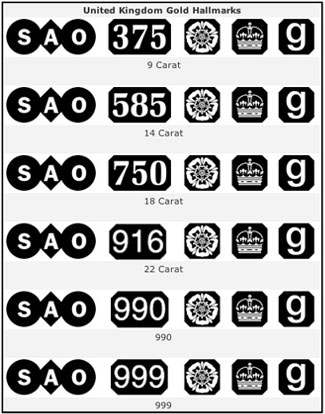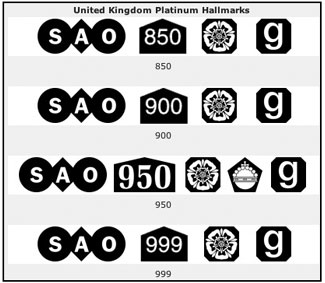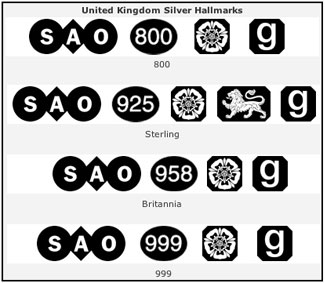Hallmarking Jewellery |
Unfortunately, all that glitters is not gold, and if you read the press you’ll know that rogue jewellers exist even in the UK. For this reason, hallmarking is the first line of defence that consumers have against forged precious metal goods.
10 THINGS YOU NEED TO KNOW
1. Hallmarking is the law in the UKA hallmark is a UK Government seal that’s stamped onto precious metal objects, such as jewellery or silverware.
The purpose of a hallmark is to certify the metal purity of the item. In other words, if an object is stamped with a ‘gold’ hallmark, then you, the consumer, knowing that it is indeed real gold – and not something else that simply looks like gold.
2. It’s an Official Stamp of QualityThe purpose of a hallmark is to certify the metal purity of the item, so you know what quality of gold, silver or platinum you are buying.
Testing precious metals for purity is called “assaying”. Therefore, the places where hallmarking is done are called Assay Offices. Only one of the four authorised UK Government Assay Offices can apply a hallmark, the official stamp of quality.
3. British hallmarking was established 700 years agoThe first Assay Office opened in London in 1327. This means that hallmarking is one of the earliest forms of consumer protection!
4. There are four UK assay officesThere are only four Assay Offices in Britain, located in London, Birmingham, Sheffield and Edinburgh.
5. There are four precious metals that require hallmarkingGold, silver and platinum, and most recently, palladium, must all be hallmarked by UK law.
Gold (including all variations of it like white, yellow and rose gold) must be further hallmarked as 9ct, 14ct, 18ct and 22ct standards, and so on.
Silver, platinum and palladium must also satisfy a percentage of purity to meet UK hallmarking requirements.
6. Hallmarking protects both consumers and jewellersBecause it’s impossible to tell how pure a precious metal item is by simply looking at it, only official assaying can guarantee standards.
Compulsory hallmarking means that the public will always have a guarantee of genuine quality in their jewellery.
Likewise, the trade of legitimate jewellers is protected from unlawful competitors who might try to pass off lower quality jewellery as the “real deal”.
7. Today both modern & traditional assaying methods are usedAssay Office laboratories now test precious metal purity using the latest technologies, including x-ray and laser analysis. However, many objects are still stamped by hand, exactly as they were 700 years ago.
8. Only officially registered hallmarks can be usedOnly jewellery that carries an officially registered British or international hallmark can be sold in the UK.
A hallmark will usually include the Assay Office town mark, together with 2-4 additional marks, such as a date letter, a metal standard symbol or a duty stamp.
There are hundreds of registered hallmark elements. If in doubt, contact the International Association of Assay Offices for more information.
1. Hallmarking is the law in the UKA hallmark is a UK Government seal that’s stamped onto precious metal objects, such as jewellery or silverware.
The purpose of a hallmark is to certify the metal purity of the item. In other words, if an object is stamped with a ‘gold’ hallmark, then you, the consumer, knowing that it is indeed real gold – and not something else that simply looks like gold.
2. It’s an Official Stamp of QualityThe purpose of a hallmark is to certify the metal purity of the item, so you know what quality of gold, silver or platinum you are buying.
Testing precious metals for purity is called “assaying”. Therefore, the places where hallmarking is done are called Assay Offices. Only one of the four authorised UK Government Assay Offices can apply a hallmark, the official stamp of quality.
3. British hallmarking was established 700 years agoThe first Assay Office opened in London in 1327. This means that hallmarking is one of the earliest forms of consumer protection!
4. There are four UK assay officesThere are only four Assay Offices in Britain, located in London, Birmingham, Sheffield and Edinburgh.
5. There are four precious metals that require hallmarkingGold, silver and platinum, and most recently, palladium, must all be hallmarked by UK law.
Gold (including all variations of it like white, yellow and rose gold) must be further hallmarked as 9ct, 14ct, 18ct and 22ct standards, and so on.
Silver, platinum and palladium must also satisfy a percentage of purity to meet UK hallmarking requirements.
6. Hallmarking protects both consumers and jewellersBecause it’s impossible to tell how pure a precious metal item is by simply looking at it, only official assaying can guarantee standards.
Compulsory hallmarking means that the public will always have a guarantee of genuine quality in their jewellery.
Likewise, the trade of legitimate jewellers is protected from unlawful competitors who might try to pass off lower quality jewellery as the “real deal”.
7. Today both modern & traditional assaying methods are usedAssay Office laboratories now test precious metal purity using the latest technologies, including x-ray and laser analysis. However, many objects are still stamped by hand, exactly as they were 700 years ago.
8. Only officially registered hallmarks can be usedOnly jewellery that carries an officially registered British or international hallmark can be sold in the UK.
A hallmark will usually include the Assay Office town mark, together with 2-4 additional marks, such as a date letter, a metal standard symbol or a duty stamp.
There are hundreds of registered hallmark elements. If in doubt, contact the International Association of Assay Offices for more information.
What is the difference between 9K and 18K gold? In the UK, jewellers tend to sell gold in these two purities. Which is better? In this guide, we explain the differences, including appearance, quality and price.
What are gold karats? A karat is a unit of gold purity. It refers to the amount of pure gold there is in a piece of jewellery. The abbreviation for karats is the letter “K”.
How do karat measurements work?One karat represents 1/24th of the gold content in a piece of jewellery or another precious object. At the top of this scale, 24K gold is 100% pure gold and at the lower end, 9K gold contains 37.5% pure gold.
Gold is mixed with alloy metalsYou might be wondering what else is in your gold jewellery, if only a percentage of it is pure gold. The answer is that all gold that is used to make jewellery is mixed with alloy metals. Why? Because gold alone is a very soft metal. If used on its own, it would quickly bend out of shape.
Therefore, the gold that is used to make jewellery must always be mixed with hard alloy metals. For example, 18K gold, which contains 75% pure gold, also contains 25% of secondary metals like silver or copper.
What gold purities are there? Gold items come in various purities, as follows:
What is the difference between 9K and 18K gold? The main difference between 9K and 18K gold is the gold content. At the lower end, 9K gold contains only 37.5% pure gold. At the higher end, 18K gold contains 75% pure gold.
The second difference is the price. 9K gold contains more alloy metals than gold. Alloy metals are cheaper than gold. Therefore, it is more expensive to make 18K gold, which contains more gold than alloy metals, than 9K gold.
Finally, you have to consider quality. 18K gold is heavier and feels more substantial and luxurious to the touch than 9K gold. Also, 18K gold items have a higher resale value than 9K gold items.
What alloy metals are mixed with gold? Gold can be alloyed with various other metals to give it strength and shape. Common alloy metals include silver, copper, platinum, palladium and zinc. Alloy metals can also be used to change the colour of gold. For example, copper gives rose gold its reddish hue.
How is white and rose gold purity measured? The purity of white gold and rose gold is measured in karats, exactly the same as yellow gold.
Is there a colour difference between 9K and 18K gold? When it comes to yellow gold, 18K gold may look richer and more yellow than 9K gold, when compared side by side. The same applies to rose gold; its golden-red colour may look slightly more intense in 18K purity when compared to 9K purity. When it comes to white gold, you cannot really see the difference. That’s because white gold is alloyed with white metals like silver and coated in rhodium to make it look silvery-white.
How do I know the purity of my gold jewellery? In the UK, you can tell your gold item’s purity by its hallmark. In fact, in Britain, all gold jewellery weighing more than 1 gram must be hallmarked. This means that it has to be first tested by an official UK Government-regulated Assay Office.
Once they have confirmed the item as gold, and verified its purity, the Assay Office stamps the gold item with a special stamp called a hallmark. That is how you’ll know what gold purity you’re buying.
Should you buy 9K or 18K gold? The choice between 9K gold and 18K depends on your budget, and how you want your jewellery to feel, perform and maintain value. In a nutshell:
You should buy 18K gold when:
9K Gold and 18K Gold – What is the difference? In short, 18K gold contains more pure gold and feels heavier than 9K gold. On the other hand, 18K is also more expensive than 9K gold. Which gold you choose, depends on the type of jewellery item you’re buying. If you’re buying a small gift or something for everyday wear, 9K gold is a great option because it’s very durable and beautiful.
However, if you’re looking for a gold item for long-term wear, like an engagement ring, then you might want to invest in 18K gold which is better quality and has a higher value. Ultimately, both 9K gold and 18K gold look the same, and both are beautiful options. So you cannot go far wrong if you choose either one.
What are gold karats? A karat is a unit of gold purity. It refers to the amount of pure gold there is in a piece of jewellery. The abbreviation for karats is the letter “K”.
How do karat measurements work?One karat represents 1/24th of the gold content in a piece of jewellery or another precious object. At the top of this scale, 24K gold is 100% pure gold and at the lower end, 9K gold contains 37.5% pure gold.
Gold is mixed with alloy metalsYou might be wondering what else is in your gold jewellery, if only a percentage of it is pure gold. The answer is that all gold that is used to make jewellery is mixed with alloy metals. Why? Because gold alone is a very soft metal. If used on its own, it would quickly bend out of shape.
Therefore, the gold that is used to make jewellery must always be mixed with hard alloy metals. For example, 18K gold, which contains 75% pure gold, also contains 25% of secondary metals like silver or copper.
What gold purities are there? Gold items come in various purities, as follows:
- 9K gold is 37.5% pure gold
- 14K gold is 58.3% pure gold
- 18K gold is 75% pure gold
- 22K gold is 91.6% pure gold
- 24K gold is 100% pure gold
What is the difference between 9K and 18K gold? The main difference between 9K and 18K gold is the gold content. At the lower end, 9K gold contains only 37.5% pure gold. At the higher end, 18K gold contains 75% pure gold.
The second difference is the price. 9K gold contains more alloy metals than gold. Alloy metals are cheaper than gold. Therefore, it is more expensive to make 18K gold, which contains more gold than alloy metals, than 9K gold.
Finally, you have to consider quality. 18K gold is heavier and feels more substantial and luxurious to the touch than 9K gold. Also, 18K gold items have a higher resale value than 9K gold items.
What alloy metals are mixed with gold? Gold can be alloyed with various other metals to give it strength and shape. Common alloy metals include silver, copper, platinum, palladium and zinc. Alloy metals can also be used to change the colour of gold. For example, copper gives rose gold its reddish hue.
How is white and rose gold purity measured? The purity of white gold and rose gold is measured in karats, exactly the same as yellow gold.
Is there a colour difference between 9K and 18K gold? When it comes to yellow gold, 18K gold may look richer and more yellow than 9K gold, when compared side by side. The same applies to rose gold; its golden-red colour may look slightly more intense in 18K purity when compared to 9K purity. When it comes to white gold, you cannot really see the difference. That’s because white gold is alloyed with white metals like silver and coated in rhodium to make it look silvery-white.
How do I know the purity of my gold jewellery? In the UK, you can tell your gold item’s purity by its hallmark. In fact, in Britain, all gold jewellery weighing more than 1 gram must be hallmarked. This means that it has to be first tested by an official UK Government-regulated Assay Office.
Once they have confirmed the item as gold, and verified its purity, the Assay Office stamps the gold item with a special stamp called a hallmark. That is how you’ll know what gold purity you’re buying.
Should you buy 9K or 18K gold? The choice between 9K gold and 18K depends on your budget, and how you want your jewellery to feel, perform and maintain value. In a nutshell:
You should buy 18K gold when:
- Your budget allows for an expensive item.
- You want jewellery that feels luxurious to the touch.
- You’re shopping for jewellery that needs to last a long time, like an engagement or wedding ring.
- You’re looking for something in an affordable price range.
- You’re not concerned about the item’s resale value.
- You want an item of fashion jewellery that you’re planning to wear occasionally.
9K Gold and 18K Gold – What is the difference? In short, 18K gold contains more pure gold and feels heavier than 9K gold. On the other hand, 18K is also more expensive than 9K gold. Which gold you choose, depends on the type of jewellery item you’re buying. If you’re buying a small gift or something for everyday wear, 9K gold is a great option because it’s very durable and beautiful.
However, if you’re looking for a gold item for long-term wear, like an engagement ring, then you might want to invest in 18K gold which is better quality and has a higher value. Ultimately, both 9K gold and 18K gold look the same, and both are beautiful options. So you cannot go far wrong if you choose either one.
|
Pledge Jewellers
|






